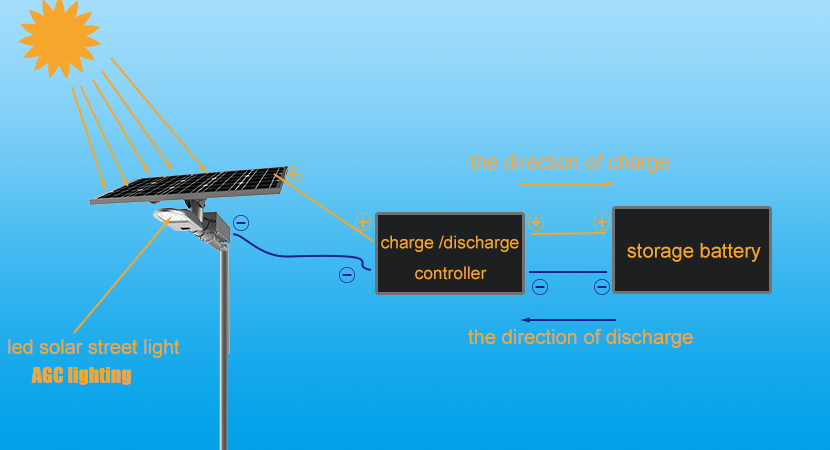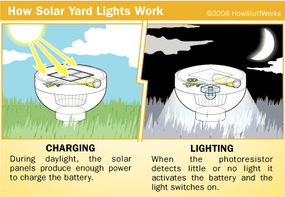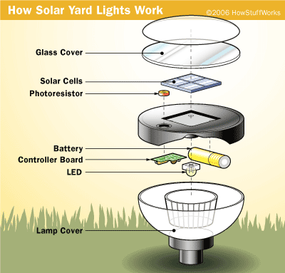Solar lights convert sunlight into electricity. They store energy in batteries for nighttime use.
This process makes them efficient and eco-friendly. Solar lights are becoming increasingly popular for home and garden lighting. They offer a sustainable solution that reduces electricity costs. But how exactly do these lights work? Understanding their mechanism can help you decide if they are right for your needs.
Solar lights consist of photovoltaic cells, which absorb sunlight during the day. This energy is then stored in rechargeable batteries. At night, the stored energy powers the LED bulbs, providing illumination. With advancements in technology, solar lights are now more efficient and reliable. They require minimal maintenance and are easy to install. Explore the science behind solar lights and see why they are a great choice for outdoor lighting.
Introduction To Solar Lights
Have you ever wondered how those garden lights illuminate so brilliantly without any wires? Welcome to the world of solar lights. They’re not just about saving energy; they’re a testament to how we can harness natural resources efficiently. From illuminating pathways to brightening outdoor spaces, solar lights have become a staple in eco-friendly living.
Brief History Of Solar Lighting
Solar lighting may seem like a modern marvel, but its roots trace back to the 19th century. The first practical use of solar energy began in 1839 with the discovery of the photovoltaic effect by Edmond Becquerel. Fast forward to the 1950s, and solar cells started powering small devices.
It wasn’t until the 1980s that solar lighting became available for consumer use. A breakthrough came with the development of more efficient solar panels, making them affordable and practical for daily use. Today, solar lights are everywhere, from streetlights to decorative garden fixtures.
Importance Of Solar Energy
Why should you consider solar lights for your home or garden? The answer is simple: sustainability. Solar energy is a renewable resource that reduces reliance on fossil fuels. By using solar lights, you contribute to a cleaner environment and help decrease carbon footprints.
Moreover, solar lights cut down electricity costs. They store energy during the day and use it to light up your space at night without affecting your electricity bill. Imagine the satisfaction of seeing your garden beautifully lit without any monthly expenses!
Have you ever thought about the potential during power outages? Solar lights offer a reliable backup. They continue to function even when the grid is down, ensuring safety and visibility.
As you consider upgrading your outdoor lighting, ponder this: what impact could your choices have on the environment and your wallet? Embracing solar lights might be the solution you’ve been seeking.
Components Of Solar Lights
Solar lights harness sunlight through solar panels, converting it into electricity stored in batteries. At night, this stored energy powers LED bulbs, illuminating the surroundings efficiently. Key components include solar panels, rechargeable batteries, LED bulbs, and a controller that regulates energy flow.
When it comes to understanding how solar lights work, it’s essential to know the key components that make them function. These components work together seamlessly to convert sunlight into electricity, store it, and then use it to power the lights. Whether you’re considering solar lights for your garden or pathway, knowing about these components can help you make informed choices.Solar Panels
Solar panels are the heart of any solar light. They capture sunlight and convert it into electrical energy. The efficiency of your solar lights largely depends on the quality and size of these panels. Larger panels can capture more sunlight, which means more energy and brighter lights at night. Have you ever wondered why some solar lights last longer than others? It often comes down to the solar panel’s efficiency.Rechargeable Batteries
Rechargeable batteries are another crucial component. They store the energy generated by the solar panels during the day. This stored energy powers the lights at night. The battery’s capacity determines how long your lights will stay illuminated. If you’ve noticed your solar lights dimming quickly, the battery might not be storing enough charge. Consider checking the battery capacity and replacing it if necessary.Light-emitting Diodes (leds)
LEDs are what actually produce light in solar lights. They are energy-efficient and can last for years without needing replacement. This makes them perfect for solar lights, which rely on stored energy. LEDs also come in various colors and brightness levels, allowing you to customize the ambiance in your outdoor space. Have you ever experimented with different LED colors in your garden? It can change the entire mood of your outdoor area. Understanding these components can help you choose the right solar lights for your needs. Are you ready to transform your outdoor space with solar lighting?Solar Panel Technology
Solar lights capture sunlight with solar panels, converting it into electricity. This energy charges batteries during the day. At night, the stored power lights up LED bulbs, providing eco-friendly illumination without relying on the grid.
Solar panel technology is the powerhouse behind solar lights. It harnesses the sun’s rays to provide clean, renewable energy. This technology is fascinating, and understanding how it works can help you appreciate the impact it has on our daily lives.Photovoltaic Cells
Photovoltaic cells are the heart of solar panels. They capture sunlight and transform it into electricity. These cells are typically made from silicon, a material that efficiently absorbs sunlight. Have you ever wondered how a small panel can light up your garden all night? It’s the magic of photovoltaic cells at work. They are designed to maximize the absorption of sunlight, even on cloudy days.Energy Conversion Process
The energy conversion process is what makes solar lights so efficient. When sunlight hits the photovoltaic cells, it generates an electric field. This electric field then creates a flow of electricity. Think of it as your smartphone charging wirelessly, only it’s using sunlight instead of a charger. The electricity generated is stored in a battery within the solar light. What happens when the sun goes down? The stored energy powers your solar lights, illuminating pathways or garden features. This cycle repeats daily, providing a consistent source of light. Solar panel technology might seem complex, but it’s incredibly practical. Have you considered adding solar lights to your home? They can reduce your carbon footprint and save on electricity bills.
Credit: www.agcled.com
Battery Storage In Solar Lights
Battery storage is a vital component of solar lights, ensuring they function even when the sun isn’t shining. These batteries harness solar energy during daylight and release it when needed, powering your garden or pathway lights throughout the night. Understanding how these batteries work can help you choose the right solar lights for your needs and maintain them effectively.
Types Of Batteries Used
Most solar lights use rechargeable batteries, commonly nickel-metal hydride (NiMH) or lithium-ion. NiMH batteries are popular due to their affordability and reliability. They can store energy efficiently, ensuring your lights stay bright.
Lithium-ion batteries, often found in higher-end solar lights, offer superior performance with longer life spans. They can hold more energy and discharge it more steadily, providing consistent illumination.
Consider your budget and lighting needs when choosing between these types. Do you want to invest in longer-lasting lithium-ion batteries or opt for cost-effective NiMH ones?
Battery Charging And Discharging
The charging process in solar lights is simple yet effective. During the day, the solar panel converts sunlight into electricity, charging the battery. This stored energy is then used at night to power the light.
Efficient discharging ensures your lights shine brightly after sunset. When the sun goes down, the battery releases the stored energy, illuminating your outdoor spaces. The quality of the battery affects how well this process works.
If you’ve ever noticed your solar lights dimming earlier than expected, it might be time to check the battery’s condition. Are they charging fully during the day? Regular maintenance can extend the life of your solar lights significantly.
Choosing the right battery can enhance your solar lighting experience. Whether you’re brightening a walkway or setting the mood in your garden, a well-functioning battery ensures your lights perform optimally. Have you considered how battery choice impacts your solar lights’ performance?
Led Technology In Solar Lights
Solar lights harness sunlight through solar panels, converting it into electricity stored in batteries. At night, LED bulbs use this stored energy to provide illumination, offering an efficient and eco-friendly lighting solution.
Solar lights have become a popular choice for environmentally conscious homeowners. A key component that makes these lights efficient and long-lasting is LED technology. LEDs, or light-emitting diodes, are what transform solar power into usable light. They’re not just tiny bulbs; they are the heart of solar lighting. You might even have some in your home without realizing their full potential. Let’s dive into how LEDs make solar lights a smart choice.Energy Efficiency Of Leds
LEDs are incredibly energy efficient. They convert most of the energy they consume into light, unlike traditional bulbs that waste a lot of energy as heat. This efficiency means solar lights can shine bright even with limited sunlight. Imagine a solar garden light. It uses a small solar panel to collect sunlight during the day. The energy is stored in a battery and later used to power the LED at night. Even in less sunny climates, these lights often stay on from dusk till dawn.Advantages Over Traditional Bulbs
LEDs have several advantages over traditional incandescent bulbs. First, they last much longer. While a typical incandescent bulb might last a year or two, LEDs can shine for over a decade. This means less maintenance and fewer replacements. They are also more durable. LEDs are solid-state lighting, which means they can withstand bumps and vibrations. This is especially useful in outdoor settings where weather and animals can pose a challenge. Finally, LEDs offer flexibility in design. They can be small and compact or arranged in larger arrays. This allows for creative lighting solutions, from tiny path lights to large garden displays. Ever tried setting up garden lights for a party and got frustrated with the power cords? With solar LED lights, you can place them anywhere the sun shines. No cords, no hassle. Just imagine the possibilities for your next gathering. Have you considered upgrading to solar LED lights yet? The benefits are clear, and the impact on your energy bill might surprise you.
Credit: home.howstuffworks.com
Environmental Benefits
Solar lights offer environmental benefits by harnessing sunlight to power LED bulbs. During the day, solar panels absorb sunlight and convert it into electricity. This stored energy lights up surroundings at night, reducing reliance on traditional electricity and lowering carbon emissions.
Solar lights are not just a modern convenience; they are a beacon of hope for a cleaner and greener planet. Their environmental benefits are profound. As we embrace solar technology, we contribute to a sustainable future, reducing the strain on Earth’s resources and combating climate change.Reduction In Carbon Footprint
Switching to solar lights can significantly cut down your carbon footprint. Traditional lighting relies heavily on fossil fuels, which emit carbon dioxide and other harmful gases. By using solar lights, you tap into a clean energy source that doesn’t contribute to air pollution. Every solar light installed is a step towards a cleaner atmosphere. Imagine if every household swapped just one traditional bulb for a solar-powered one. The cumulative effect could be immense. Think about the impact you can have. Your choice to use solar lights could inspire others, creating a ripple effect that contributes to a healthier planet.Sustainable Energy Source
Solar energy is abundant and renewable. Unlike fossil fuels, which are finite, the sun provides an endless supply of energy. By harnessing this power, you’re choosing a sustainable solution that can be used indefinitely. Moreover, solar lights require minimal maintenance. Once installed, they operate efficiently with little intervention, saving you time and money. Solar lights also promote energy independence. By generating your own power, you rely less on external energy sources, reducing demand on the grid and contributing to energy security. Have you thought about the long-term benefits? Imagine the savings and peace of mind knowing you’re not just conserving energy but also safeguarding the environment for future generations.Applications Of Solar Lights
Solar lights are becoming popular for many lighting needs. They offer eco-friendly solutions for homes and businesses. Their versatility makes them suitable for various applications. Let’s explore how different sectors benefit from solar lighting.
Residential Uses
Homeowners use solar lights to brighten their outdoor spaces. They are perfect for gardens, pathways, and patios. Solar garden lights enhance the beauty of lawns. They provide soft lighting at night without raising electricity bills. Pathway lights ensure safe walking paths after dark. They also add charm to the yard.
Security is another area where solar lights shine. Motion-sensor lights deter unwanted visitors at night. These lights charge during the day and illuminate when needed. Solar floodlights can cover large areas, making them ideal for driveways and backyards.
Commercial And Industrial Applications
Businesses use solar lights to reduce energy costs. Parking lots and walkways benefit from solar-powered lighting. They provide bright light, ensuring safety for customers and employees. Solar streetlights offer an efficient solution for industrial areas.
Factories and warehouses also use solar lights. They illuminate large spaces without extra wiring. Solar lighting in these areas reduces the carbon footprint. It aligns with sustainability goals and can lead to significant energy savings.
Construction sites use solar lights for temporary lighting needs. They are easy to set up and move. This flexibility makes them a favorite in dynamic environments.

Credit: www.solarilluminations.com
Challenges And Innovations
Solar lights have become popular for their eco-friendly benefits. Yet, they face challenges and innovations that keep them evolving. These lights rely on sunlight, which can be both an advantage and a drawback.
Weather Dependence
Solar lights need sunlight to charge. Cloudy days can reduce their efficiency. In regions with less sunlight, this poses a challenge. During winter months, shorter days limit charging time. This can affect how long lights stay on at night. Weather patterns impact their performance significantly.
Advancements In Solar Technology
Despite weather challenges, technology advances improve solar lights. New solar panels are more efficient. They capture more sunlight even on cloudy days. Battery technology has also improved. Modern batteries store energy better, extending light time at night. Smart sensors now adjust light intensity based on surrounding brightness. These innovations make solar lights more reliable and efficient. Continuous research leads to better materials and designs.
Future Of Solar Lighting
The future of solar lighting is bright and promising. As technology advances, solar lights become more efficient and accessible. These lights harness the sun’s power to illuminate our nights. Their popularity grows, driven by environmental benefits and cost savings. Solar lighting transforms how we light our homes and cities.
Trends In Solar Energy
Solar energy trends show rapid growth. More people choose solar lights for their homes. These lights are eco-friendly and reduce electricity bills. The technology behind solar lights improves. Panels are more efficient and last longer. This makes solar lighting a smart choice.
New designs and features emerge. Smart solar lights can be controlled from phones. They adjust brightness based on needs. These innovations make solar lights more appealing to consumers. The market for solar lights expands globally.
Potential For Global Impact
Solar lights have the potential to impact the world. They offer solutions for regions without electricity. Communities in remote areas use solar lights to illuminate homes. This improves safety and quality of life.
Solar lighting reduces reliance on fossil fuels. It cuts down carbon emissions. This helps fight climate change. As more countries invest in solar energy, the global impact grows. Solar lights play a key role in sustainable development. They provide light while protecting the planet.
Frequently Asked Questions
Do Solar Lights Need Sun Or Just Light?
Solar lights need direct sunlight to charge efficiently. Indoor or artificial light sources are less effective for charging. Sunlight provides the necessary energy to power the lights for nighttime use. Without adequate sunlight, their performance and illumination duration can decrease significantly.
How Long Do Solar Lights Usually Last?
Solar lights usually last between 2 to 5 years, depending on quality and usage. Regular maintenance extends their lifespan. Rechargeable batteries may need replacement every 1 to 2 years for optimal performance. Investing in high-quality solar lights ensures better durability and efficiency, reducing the need for frequent replacements.
How Does A Solar Light Turn On?
A solar light turns on automatically at night. During the day, its solar panel charges the battery. The stored energy powers the LED bulb after sunset, providing illumination. This process repeats daily, ensuring efficient and sustainable lighting without manual intervention.
How Do I Get My Outdoor Solar Lights To Work?
Ensure solar panels are clean and positioned for maximum sunlight. Check batteries and replace if needed. Make sure the switch is on. Test lights by covering the panel to simulate darkness. Inspect connections for any damage or loose wires.
Conclusion
Solar lights offer simple, eco-friendly solutions for outdoor lighting needs. They use sunlight to charge during the day. At night, they illuminate spaces beautifully. No wires, no hassle. Just clean energy lighting. Easy to install and maintain. Perfect for gardens, pathways, and patios.
Affordable and sustainable. Solar lights are reliable and effective. They save electricity and reduce carbon footprint. Choosing solar lights supports a greener planet. Enjoy bright nights with solar power. Efficient and practical. Ideal for every home. Embrace solar technology and light up your life.
Make the switch today.

